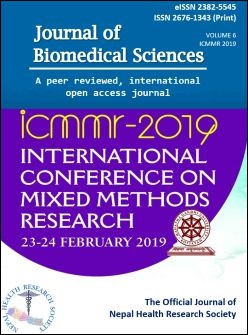Clinical disparity of oxidative stress with blood pressure
DOI:
https://doi.org/10.3126/jbs.v6i3.26821Keywords:
Blood Pressure, MDA, oxidative stress, SODAbstract
Background: Cardiovascular disease is one of the leading causes of mortality and morbidity in India and worldwide. Hypertension is a major public health problem because of its high frequency and concomitant risk of cardiovascular disease, kidney disease, and stroke. World Health Organization named it a Silent killer as hypertension is asymptomatic during its clinical course. Experimental evidence supports a role for oxidative stress in vascular injury and hypertension. This study was undertaken, to compare the serum levels of malondialdehyde (MDA) and super-oxide dismutase (SOD) among normotensive, prehypertensive and hypertensive subjects.
Materials and methods: In this cross-sectional study, 34 normotensives, 44 prehypertensive and 45 hypertensive subjects were included. The participants were subjected to selection protocol consisting of physical examination and biochemical analysis. All subjects underwent blood pressure measurement, total cholesterol, and oxidative stress marker estimation, especially SOD and MDA. The comparison of parameters between the group was carried out using One Way ANOVA. The correlation between the parameter was analyzed by Karl Pearson Correlation Coefficient using SPSS 20.0.
Result : The MDA (nmol/ml) in normotensive, prehypertensive and hypertensive patients was 2.55±0.072, 3.43±0.44 and 4.01±0.37 respectively. SOD (U/ml) level in normotensive, prehypertensive and hypertensive patients was 13.47±1.96, 11.57±0.81, and 8.52±1.78 respectively. Systolic and diastolic blood pressure had a negative correlation with SOD. MDA levels show a positive correlation with systolic blood pressure and diastolic blood pressure. Total cholesterol had no significant with SOD and MDA.
Conclusion: The present study showed a strong association of oxidative stress with systolic and diastolic blood pressure.
Downloads
Downloads
Published
How to Cite
Issue
Section
License
This license enables reusers to distribute, remix, adapt, and build upon the material in any medium or format, so long as attribution is given to the creator. The license allows for commercial use.




